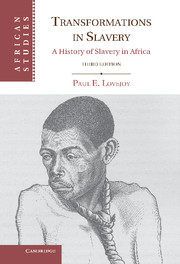Book contents
- Frontmatter
- Contents
- Maps and Tables
- Note on Currencies, Weights, and Measures
- Preface
- Preface to the Second Edition
- Preface to the Third Edition
- 1 Africa and Slavery
- 2 On the Frontiers of Islam, 1400–1600
- 3 The Export Trade in Slaves, 1600–1800
- 4 The Enslavement of Africans, 1600–1800
- 5 The Organization of Slave Marketing, 1600–1800
- 6 Relationships of Dependency, 1600–1800
- 7 The Nineteenth-Century Slave Trade
- 8 Slavery and “Legitimate Trade” on the West African Coast
- 9 Slavery in the Savanna during the Era of the Jihads
- 10 Slavery in Central, Southern, and Eastern Africa in the Nineteenth Century
- 11 The Abolitionist Impulse
- 12 Slavery in the Political Economy of Africa
- Epilogue
- Appendix Chronology of Measures against Slavery
- Notes
- Select Bibliography
- Index
- Books in this series
4 - The Enslavement of Africans, 1600–1800
Published online by Cambridge University Press: 05 June 2012
- Frontmatter
- Contents
- Maps and Tables
- Note on Currencies, Weights, and Measures
- Preface
- Preface to the Second Edition
- Preface to the Third Edition
- 1 Africa and Slavery
- 2 On the Frontiers of Islam, 1400–1600
- 3 The Export Trade in Slaves, 1600–1800
- 4 The Enslavement of Africans, 1600–1800
- 5 The Organization of Slave Marketing, 1600–1800
- 6 Relationships of Dependency, 1600–1800
- 7 The Nineteenth-Century Slave Trade
- 8 Slavery and “Legitimate Trade” on the West African Coast
- 9 Slavery in the Savanna during the Era of the Jihads
- 10 Slavery in Central, Southern, and Eastern Africa in the Nineteenth Century
- 11 The Abolitionist Impulse
- 12 Slavery in the Political Economy of Africa
- Epilogue
- Appendix Chronology of Measures against Slavery
- Notes
- Select Bibliography
- Index
- Books in this series
Summary
The growth of the export market, particularly the spectacular surge of the late seventeenth and eighteenth centuries, could not have taken place without a corresponding increase in the ability to enslave people, and, consequently, an intensification of political violence. While this adjustment implies disorder in the social framework wherever the external trade was important, the effective organization of slave supply required that political violence be contained within boundaries that would permit the sale of slaves abroad. The inherent contradiction in this situation was resolved through a separation of the commercial infrastructure from the institutions of enslavement. On the one hand, the disruption in the process of enslavement was associated with political fragmentation. On the other hand, the consolidation of independent commercial networks permitted the movement of slaves within Africa and beyond. Both dimensions were necessary features of the emerging system of slavery in this African context. The export of about 11.7 million slaves from 1500 to 1800, including the astronomical increase between 1650 and 1800 in the Atlantic sector, could not have occurred without the transformation of the African political economy. The articulation of the supply mechanism required the institutionalization of enslavement, which was disruptive (examined in this chapter), and the consolidation of a commercial infrastructure, which was integrative (examined in the next chapter).
A Politically Fragmented Continent
The most pervasive feature of African history in the period from 1600 to 1800 was the inability of military and political leaders to consolidate large areas into centralized states, despite the presence of many small polities. In the sixteenth century, only Songhay and Borno can truly be called empires. The other states of the period were much smaller than these, and large areas had no states at all. In 1800, there were no large empires, although the number of states as a whole had increased, and the area of stateless societies had been reduced. Political fragmentation accompanied by instability was characteristic of the period. This political environment was well suited for enslaving people.
- Type
- Chapter
- Information
- Transformations in SlaveryA History of Slavery in Africa, pp. 66 - 87Publisher: Cambridge University PressPrint publication year: 2011
- 1
- Cited by



